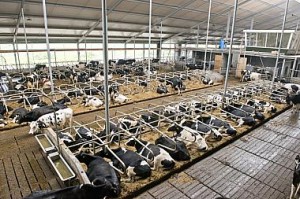 Cow longevity economics and cost benefits of keeping a cow in the herd. The significance of keeping cows comfortable, healthy and well fed, pays dividends when they are in the herd longer. This is according to cow expert Albert DeVries, who warns that culling a cow in a lactation can cost a farm $1000.
Cow longevity economics and cost benefits of keeping a cow in the herd. The significance of keeping cows comfortable, healthy and well fed, pays dividends when they are in the herd longer. This is according to cow expert Albert DeVries, who warns that culling a cow in a lactation can cost a farm $1000.
High costs of culling
A large number of dairy cows leave the herd in early lactation largely due to metabolic health reasons, and the risk of death is highest early in lactation, writes Albert DeVries. The most common “reason” for a cow to leave the herd in the US is death, comprising 21 per cent of the turnover of cows. Involuntary culling of cows early in lactation is expensive, in the order of $500 to $1000 (380 to 760 EURO) per cow (US data). This does not include losses in milk yield due to disease or extra labor and delayed replacement. Efforts to reduce death rates and improve early lactation health are therefore often profitable. Cull risks vary within herds, depending on such things as health, milk production and reproduction. External factors are the availability of replacement heifers, parlor capacity or land availability.
Cull risks and reasons
For a cow the risk of being culled is larger during the first 60 days of lactation, which is a period when cows often have problems. In general, pregnancy, higher milk production, younger age, and the absence of health issues such as metabolic problems, lameness or mastitis reduced the risk of culling. A study from 2010 on farms in the eastern US showed that the number one reported reason of cows leaving the herd was death, 21 per cent of all cullings (including cows that could not walk onto the truck and had to be euthanized), followed by reproduction problems 18 per cent , injury or other reason 14 per cent and low production and mastitis, both 12 per cent . Death is a big concern. It is not only an economical issue but a potential consumer issue as well.
Cow longevity
Several herd factors are associated with cow longevity: herds that are trying to expand or use cross bred cows had lower cull rates. In a study with larger dairy herds in the eastern US, the culling risk increased for cows in herds with shorter days to first insemination and herds that used a synchronized breeding program. An increase in on-farm mortality (euthanasia and death) in dairy herds has been reported in several countries in the last decade. Death rate in Sweden was 6.6 per cent in 2010. In Swedish dairy herds, higher mortality was associated with larger herd size, longer calving intervals, and herds that had Swedish Holstein as the predominant breed. Lower mortality was observed in herds with a higher herd average milk yield, during the fall and winter, and in organically managed herds. In a review of the literature, these authors reported that in general death risk (mortality rate) increased with an increased proportion of purchased cows, no pasture-grazing, larger herd sizes and lower herd average milk yield.
Keeping the cow in the herd
Cows are culled to make place for the new heifers. But with such a good availability of heifers, like the present situation in the US, farmers are less likely to see the opportunities that lie in working with management and barn environment to try and keep cows healthy, so that they can be kept in the herd, and the hidden costs behind the culling, the tip of the ice berg of e.g. lameness and mastitis that Rushen mentioned: lower yield, vet costs etc. can be avoided.
Key messages:
• Cow longevity depends on intrinsic and extrinsic factors.
• Survival analysis has shown that a large number of cows leave the herd early in lactation largely due to metabolic health reasons.
• The risk of death is greatest early in lactation.
• Forced culling of cows early in lactation is expensive, in the order of $500 to $1000 per cow.
• Efforts to reduce death rates and improve early lactation health, and therefore intrinsic cow longevity, are to be profitable.
• The average cow longevity is determined by extrinsic economic factors unrelated to an individual cow’s health and performance. To extend the average cow longevity, dairy farmers would need to be motivated to bring fewer heifers into the herd and therefore cull fewer cows.
Final remarks
This could be accomplished by creating fewer dairy heifer calves, for example through delayed inseminations in heifers and/or cows, or not breeding non-pregnant cows that are late in lactation.
A portion of the heifers and cows could also be inseminated with beef semen and the crossbred calves could be sold.
Recent analyses have shown that these are viable options under some constraints and price assumptions but cannot be generally recommended under current market conditions.
Thanks to cow expert Albert DeVries for this study!

